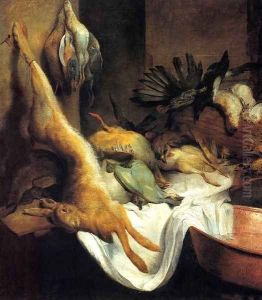Jan Roos Paintings
Jan Roos, also known as Giovanni Rosa, was a Flemish painter who was born in Antwerp in 1591. Roos specialized in still life and flower paintings, but he is most renowned for his masterful depictions of animals, particularly his realistic renderings of sheep and game. His work is characterized by a meticulous attention to detail and a rich, vibrant use of color, which was typical of the Flemish Baroque tradition of the early 17th century.
Roos received his artistic training in the workshop of Cornelis van der Voort, and he became a master in the Antwerp Guild of Saint Luke in 1616. His early career was marked by his work in Antwerp, but like many artists of his time, Roos sought opportunities elsewhere. In 1620, he moved to Genoa, Italy, which was a thriving center of cultural and artistic exchange during the Baroque period. This period was marked by a significant Flemish presence in the city, with artists such as Anthony van Dyck, Cornelis de Wael, and Lucas and Cornelis de Wael contributing to the artistic scene.
In Genoa, Roos became a sought-after painter and established a successful workshop. He received numerous commissions from the Genoese aristocracy and painted works for many important families, including the Spinola, Pallavicini, and Imperiali families. His Italian experience allowed him to absorb and integrate Italianate elements into his art, blending them with his Flemish technique.
Roos' paintings often feature a combination of still life elements and animals, set against a dark background that enhances the illusion of depth and the lifelike quality of his subjects. His compositions exhibit a harmonious balance between the various elements, displaying his skill in arranging objects and figures to create a cohesive and visually pleasing whole.
Jan Roos' legacy extends to his influence on local Genoese painters, as well as the dissemination of Flemish painting techniques in Italy. He is also known for having trained his son, Philips Roos (also known as Rosa da Tivoli), who became a prominent painter in his own right. Jan Roos died in Genoa in 1638, leaving behind a body of work that reflects a successful fusion of Flemish precision and Italian exuberance.
